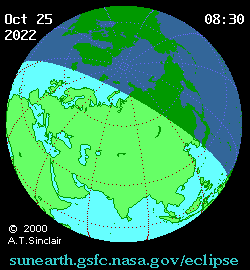On Tuesday (Oct.25), the moon will pass in front of the sun causing a partial solar eclipse, the last solar eclipse of 2022.
This year’s second and final solar eclipse will only be visible from some areas of Earth — mainly parts of Europe, Africa, and Asia. This eclipse won’t be visible in the United States.
If you don’t live in one of those areas, don’t fret. Even though millions of observers across the Earth won’t be able to see the partial solar eclipse in person, they can watch the solar event live on the internet across a variety of websites. Be sure to check out our guide on how to watch the partial solar eclipse online for links to a variety of livestreams. We will also stream the event live here on Space.com.
Related: What time is the last solar eclipse of 2022 on Oct. 25?
The time the eclipse begins will depend on where on the globe observers are based. The eclipse will begin over the Atlantic Ocean at 08:58:20 Universal Time (GMT), which would be about 4:58 a.m. EDT. It will end at 9:01 a.m. EDT (1301 GMT).
The eclipse peak will occur at 7 a.m. EDT (1100 GMT), according to (opens in new tab) retired NASA astrophysicist and eclipse expert Fred Espenak.
Nowhere on Earth will be exposed to a total solar eclipse on Tuesday, Oct. 25. This is because during this eclipse the moon and the sun won’t be perfectly aligned. Instead, the sun will appear as if it has had a monstrous bite taken out of it, a suitably haunting image for the week before Halloween.
The maximum amount the sun is covered by the moon as seen from Earth during an eclipse is called the point of central eclipse. This is where the center of the moon is most closely aligned with the center of the sun.
The point of central eclipse will be at its maximum over the North Pole where the moon will cover 82% of the sun during this partial solar eclipse. This point isn’t stable and drifts across Earth during an eclipse.
As the point of central eclipse moves away from the North Pole, observers in Russia will see around 80% of the sun eclipsed by the moon. This level of solar coverage will drop to around 70% over China, 63% over Norway, and 62% over Finland.
Like all solar eclipses, partial or total, Tuesday’s solar eclipse will only be visible from certain parts of the globe. This is because the moon is much smaller than the Earth so its shadow can only cover an area of a few hundred miles.

If you want to view the partial solar eclipse (or any solar eclipse) in person, be sure to read our guide how to observe the sun safely. Never attempt to look at the sun without proper eye protection, as the sun’s ultraviolet (UV) and infrared (IR) rays can damage one’s eyes even during a partial eclipse. Even if you don’t have special eyewear designed for eclipse viewing, you could easily make a pinhole camera at home to view the eclipse live.
Editor’s Note: If you get a good photo of the partial solar eclipse and would like to share it with Space.com’s readers, send your photo(s), comments, and your name and location to [email protected].

